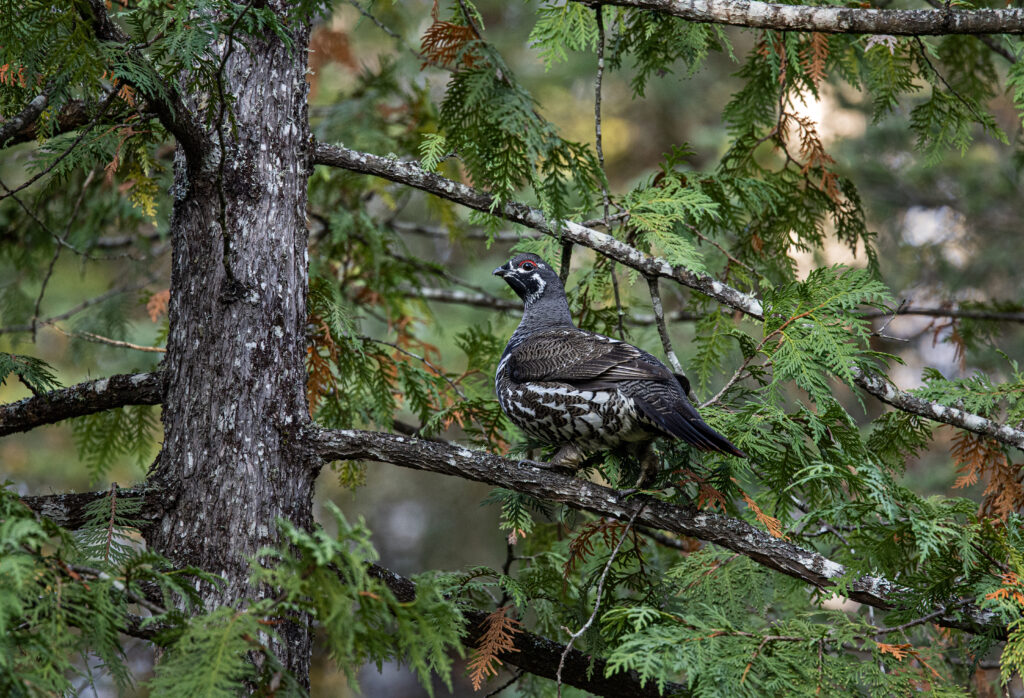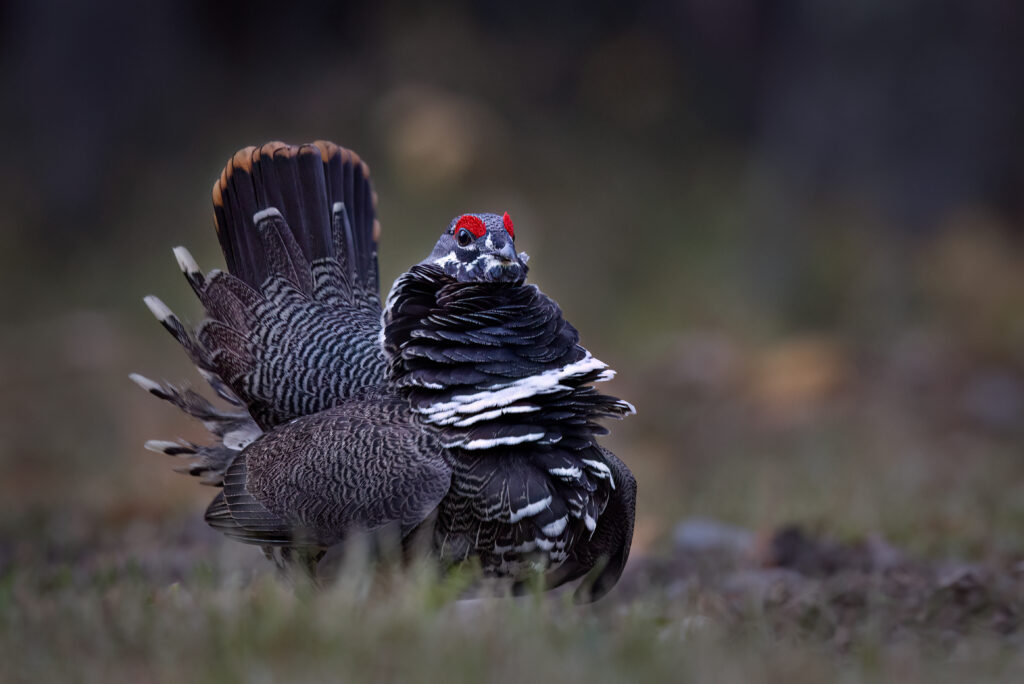Not so long ago, a moose caused an uproar on the U.S.-Canada border when it became trapped in a canal. The swimming moose was caught in the Soo Locks, where Ontario Ministry of Natural Resources biologists rescued it.
The errant moose is one of countless wildlife species that make their way north across the international line each year. Most slip through unseen. Usually it’s a lone moose, maybe a pack of wolves. Not a veritable animal caravan. Now, however, pressure is building on at least one species to border-cross en masse. No one is sure whether it will sneak through the woods or drop in from the air. But, like the first cold snap of autumn, coming it likely is: the spruce grouse (Falcipennis canadensis).
Spruce grouse, also fittingly called Canada grouse (as well as fool’s hens for their docile nature), subsist solely on spruce needles for much of the year. Spruce and other boreal, or northern, conifers fare best in regions with long, cold winters and short summers. It’s the same for spruce grouse.
Scientists at the Minnesota Department of Natural Resources (MN DNR) are tracking the grouse’s movements, binoculars up and hiking boots on, through the black spruce-jack pine forests these shy birds depend on for food and cover. With warming temperatures, boreal conifers are moving yet farther northward. “As the boreal forest shifts to the north with climate change, spruce grouse are expected to shift with their habitat,” says MN DNR lead grouse biologist Charlotte Roy.
Today spruce grouse live in the conifer forests of northern and western North America, according to Jodie Provost of the North American Grouse Partnership, a group that promotes the conservation of grouse species and their habitats. “The future of spruce grouse depends on healthy and connected coniferous forests, especially as the southern edge of their range shrinks northward,” says Provost.

In Canada, surveys suggest that spruce grouse populations have increased since 1970. “At the moment,” states a Government of Canada report, “there do not appear to be any pressing conservation concerns for this species.”
A short distance south, however, it’s a different story. Minnesota is one of the grouse’s last U.S. strongholds. On an MN DNR map of the state’s spruce grouse breeding sites, the 15 or so red dots marking those locations trace the Canadian border. The dots are warning signals of a species that’s moving ever-closer to climate defection. MN DNR biologists are bushwhacking through the boreal forest, looking for clues to when that might happen.
Into the Deep, Dark Forest
Late October near the border, pitch-black in the hours before dawn. Rain comes down sideways, making Minnesota State Highway 11 out of Baudette almost invisible from our 4×4. At the wheel is Scott Laudenslager, a wildlife biologist at the MN DNR. It’s 4 a.m., and he’s leading us on a wild grouse chase.
After a dozen or more miles, we turn into the Beltrami Island State Forest and rattle down a deserted, rutted side road that seems to go on forever. But that remoteness is how our quarry prefers it. We’re in search of the spruce grouse. We might as well be looking for a needle in a haystack.
“Finding spruce grouse in the forest is a tall order because they’re so secretive,” says Laudenslager as the track ends and he skids to a stop. Doors open with a muffled click, and we slide our way down a bramble-lined trail that’s slippery with wet leaves, headlamps on in the pre-dawn darkness. A mile or more in, a small cabin looms out of the blackness. We silently approach the front door, and are welcomed by Martin Kehoe, the cabin’s owner.
After a brief greeting, Kehoe whispers: “We need to be very quiet, and if we’re lucky the spruce grouse will start coming in right at dawn.” Spruce grouse plural? Coming in? It would be just as surprising to see forest-dwelling Hobbits.
Kehoe has owned the hut since 1986; owners before him were deer hunters and loggers. The property sits near 40 acres of public land, much of it “deep in the northern Minnesota forest,” says Kehoe. “Today’s cabin was likely built in the 1930s as an outbuilding for the original cabin, which rotted away for lack of a metal roof. I’m pretty enthralled by where it is, and it seems the spruce grouse are, too.”
According to a 1994 issue of the newsletterFool-Hens Forever, published by the Spruce Grouse Society (an organization that’s now “extinct”), spruce grouse in Minnesota and Michigan are usually found in jack pine forests, while Wisconsin spruce grouse, like those in New York’s Adirondack Mountains, are more likely to live in spruce swamps. Here at Kehoe’s dwelling, jack pines stipple the landscape.
“Fool Hens” A-Plenty
“I don’t know many spots where you can find spruce grouse as reliably,” says Laudenslager. As if on cue, we hear scratching. Peering out a cabin window and through the rays of first light, we make out 10, perhaps 15, low shapes parading their way around the pines and along a “landing strip” in front of the hut.
The strip is where Kehoe places grit—small stones or pebbles. Spruce grouse need grit to grind food in their gizzards, and to change from a fall diet of berries and leaves to a winter diet of fibrous spruce needles. In autumn, adults and young pick up grit in the early morning along roads, streams and lakes.
The sky turns sunrise-pink and the low shapes become more than a dozen spruce grouse. Kehoe’s grouse have appeared every fall, searching for grit. “This was an especially good morning,” says Kehoe. “I hope the grouse come back long into the future, but who knows?”
Answers in Feather DNA
For now, the birds are faring well enough in Minnesota that the state still allows a spruce grouse hunting season. In past such seasons, the MN DNR encouraged hunters to submit wing or tail feathers, says Roy, along with GPS coordinates of harvest locations, for a DNA study of the birds’ habitat. “We’re using grouse genetics [from the birds’ feathers] to identify changes in their habitat connectivity over time,” Roy says.
In the MN DNR study report,Spruce Grouse as Indicators of Boreal Forest Connectivity, released in 2023, Roy and other researchers report that “genetic data indicate that spruce grouse exist as a single interconnected population in Minnesota, with coniferous forest land cover and lower average temperatures at the time of spring dispersal [from winter roosts] the best predictors of gene flow. Therefore, climate change could threaten the persistence of this interconnected population.”
The biologists also found that the cooler northwestern and northeastern parts of the state’s spruce grouse range might provide climate “refugia”; the central region may be the most vulnerable to warmer conditions. Roy says that the research “highlights climate change and associated changes in conifer forest cover as important considerations for spruce grouse population connectivity at their range periphery”—such as Minnesota just south of the Canadian border.
A Cautionary Tale
The spruce grouse has a close relative in the Russian Far East, the Siberian grouse (Falcipennis falcipennis). It may offer a crystal ball look into the North American spruce grouse’s future. The Far East species is in sharp decline due to warming temperatures and coniferous forests shifting northward, an international team of biologists discovered. They reported their results in 2022 in the journal Avian Research.
“Climate change has influenced the distribution of Siberian grouse dramatically,” the scientists write, “causing the species to lose most of its habitat and live in a small refugium.”
Whither cold temperatures and conifer trees, whether in the Russian Far East or in the northern U.S., thence the spruce grouse.

